July 1, 2022
Air Date: July 1, 2022
FULL SHOW
SEGMENTS
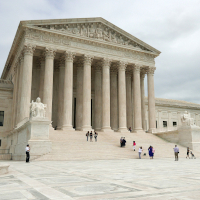
Supreme Court Limits EPA Power
View the page for this story
In a major 6 to 3 decision with sobering implications for climate policy, the conservative majority of the Supreme Court ruled that the Environmental Protection Agency overstepped its authority when it created guidelines for how utilities generate electricity. Vermont Law School Professor Pat Parenteau joins Host Steve Curwood to discuss how the decision goes against precedent and hampers efforts to tackle climate change. (08:48)
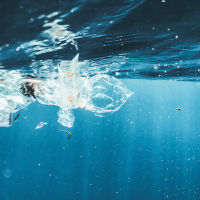
Beyond the Headlines
/ Peter DykstraView the page for this story
Environmental Health News Editor Peter Dykstra joins Host Steve Curwood to discuss the statistic that less than 50% of our world’s annual grain production is eaten by humans. They then review the innovative microplastic-removing “fishbots” coming out of a research group at Sichuan University and finish up with an anniversary for the Hoover Dam, a massive source of water and hydropower approved for development 93 years ago. (05:10)
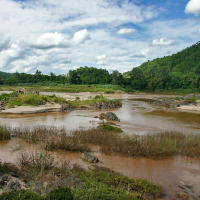
Saving the Mekong River
View the page for this story
The Mekong River is a vital lifeline for more than 65 million people in Southeast Asia, so when a Thai man named Niwat Roykaew heard about a “rapids-blasting” project on the Mekong that would have detrimental effects on the river's health, he began to mobilize to stop the project. In 2020 the Thai government canceled its part of the project and Niwat Roykaew was awarded the 2022 Goldman Prize for Asia. He joined Host Bobby Bascomb to talk about his work in safeguarding the Mekong River's biodiversity. (06:10)

Saltier Soils in a Warming World
/ Fred PearceView the page for this story
Rising seas and temperatures are exacerbating the perennial problem of increasing salinity on both coastal and inland farmland. Journalist Fred Pearce joins Host Bobby Bascomb to discuss how this is affecting farmers from Vietnam to Bangladesh and talk about potential solutions. (11:31)
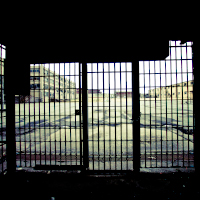
Climate and Punishment
/ Alleen BrownView the page for this story
America’s aging prison facilities are largely unprepared for climate impacts and often lack air conditioning, wildfire evacuation plans, and hurricane strategies, and some inmates have died from extreme heat. Journalist Alleen Brown talks with Host Steve Curwood about how U.S. prisons reveal the intersection of mass incarceration, systemic racism, and climate change. (15:31)
Show Credits and Funders
Show Transcript
220701 Transcript
HOSTS: Steve Curwood
GUESTS: Alleen Brown, Pat Parenteau, Fred Pearce, Niwat Roykaew
REPORTERS: Peter Dykstra
[THEME]
CURWOOD: From PRX – this is Living On Earth.
[THEME]
CURWOOD: I’m Steve Curwood.
BASCOMB: And I’m Bobby Bascomb.
The US Supreme Court rules the EPA can’t address climate change by regulating how utilities generate electricity.
PARENTEAU: It's terrifying that we can't get any of the branches of our government, the Congress, the courts, or the executive branch to come together and deal with the problem with the solutions that are in plain sight.
CURWOOD: Also, a jail term can become an unjust death sentence in prisons ill-equipped to deal with extreme heat.
BROWN: People of color are disproportionately incarcerated. When these climate impacts are hitting the system of mass incarceration, it's disproportionately hitting people of color. So, it's absolutely an environmental justice issue.
CURWOOD: That and more this week on Living on Earth – stick around!
[NEWSBREAK MUSIC: Boards Of Canada “Zoetrope” from “In A Beautiful Place Out In The Country” (Warp Records 2000)]
[THEME]
Supreme Court Limits EPA Power
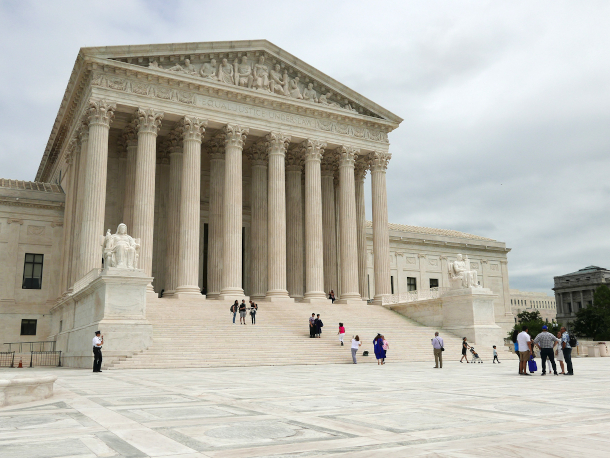
The court's decision in West Virginia v. EPA says that the agency effectively does not have the power to regulate the mix of generation sources to address carbon dioxide emissions from power plants. (Photo: Susan Melkisethian, Flickr, CC BY-NC-ND 2.0)
BASCOMB: From PRX and the Jennifer and Ted Stanley Studios at the University of Massachusetts, Boston this is Living on Earth. I’m Bobby Bascomb.
CURWOOD: And I’m Steve Curwood.
Coal-fired power plant operators may be cheering the recent Supreme Court ruling against the Environmental Protection Agency, but critics say the high court has shredded key precedents and ignored technical competence. The case, known as West Virginia versus EPA, was brought against the Obama era Clean Power Plan, even though those rules never went into effect. Vermont Law School professor Pat Parenteau joins us now. So, Pat, what exactly did the court rule?
PARENTEAU: Well, the court decided that EPA's interpretation of its authority under the Clean Air Act to require shifting from carbon intensive sources of electricity like coal to cleaner sources like gas and wind and solar went beyond the authority that Congress gave to EPA in the 1970 Clean Air Act.
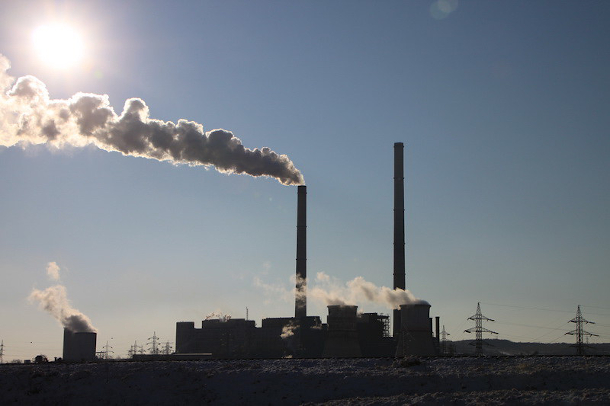
The 6-3 ruling in West Virginia v. EPA holds that EPA needs clearer direction from Congress in order to regulate emissions from power plants by requiring states to use more gas, solar and wind to generate electricity. (Photo: Emilian Robert Vicol, Flickr, CC BY 2.0)
CURWOOD: What were the reasons that the Court used to decide this case?
PARENTEAU: The Court has now formalized -- and this is an opinion by the Chief Justice Roberts, six to three decision -- has now formalized what it calls the "major question doctrine," which means when an agency adopts a new interpretation, and a new approach to a problem like climate change and greenhouse gas emissions, and adopts a system-wide approach to dealing with a problem, which is a systemic problem, that under this new doctrine, the Court is going to demand that Congress has been explicit in authorizing the agency to take this new, broader approach to a really big problem like climate change with really big economic and political consequences. The Court didn't specify exactly how Congress could make its intent clearer or more manifest; it simply said, in its view, Congress was not clear enough in Section 111(d) of the Clean Air Act, and therefore EPA has no authority to require generation shifting towards cleaner sources of electricity.
CURWOOD: Pat, I'm confused. I thought for years the Supreme Court conservatives have been saying, "you've got to look to the text of the law." It sounds like you're telling me that in this case, the Court says, ehh, "text smext, we decide."
PARENTEAU: That's right. The Court is saying text is not enough when it comes to this new interpretation; and again, this is the Court's characterization, EPA argued their interpretation wasn't new. EPA pointed to countless examples -- acid rain, mercury controls, interstate air pollution -- where the agency had looked at the system as a whole and looked at averaging of emissions and looked at trading of emissions under a cap and trade program in numerous circumstances. So EPA was saying, our interpretation isn't new. It's consistent with the way we've looked at major pollution problems over the course of the last five decades.
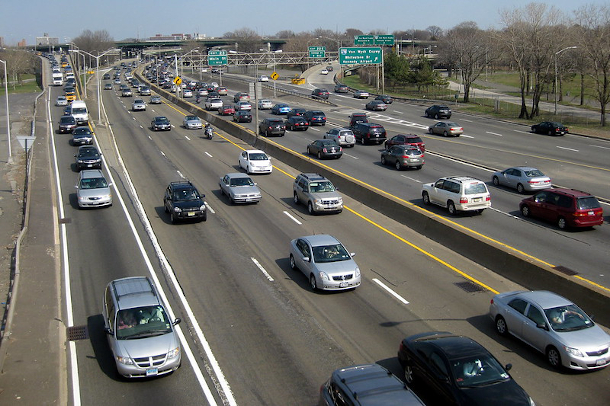
The high court said that the Obama administration’s 2015 Clean Power rule which attempted to shift states away from coal and toward natural gas and renewable sources was an unlawful expansion of EPA’s power. (Photo: Wally Gobetz, Flickr, CC by NC ND 2.0)
CURWOOD: Now, what are the implications now for the EPA's authority to regulate greenhouse gases from power plants and elsewhere, perhaps in the economy as well?
PARENTEAU: Well, the Court's only decided what the EPA cannot do, which is, as we've talked, require generation shifting. But the Court doesn't say what EPA can do. And it doesn't really talk about what are the options that would be permissible interpretations. It didn't provide even a hint of that. And Justice Kagan's dissent excoriates the majority for not doing that. If the court thinks it knows what Congress meant to give EPA in terms of authority, why didn't it say so? But it didn't. So we're left, and EPA is left wondering, what options do we still have at our disposal? And we'll have to wait until 2024 to find out what EPA thinks it still has the authority to do. That's when EPA will issue a new rule under Section 111(d) of the Clean Air Act.
CURWOOD: What does this ruling say about other agencies' rulemaking power? I know the Securities and Exchange Commission wants publicly traded businesses to say what their risk and exposure to climate disruption is.
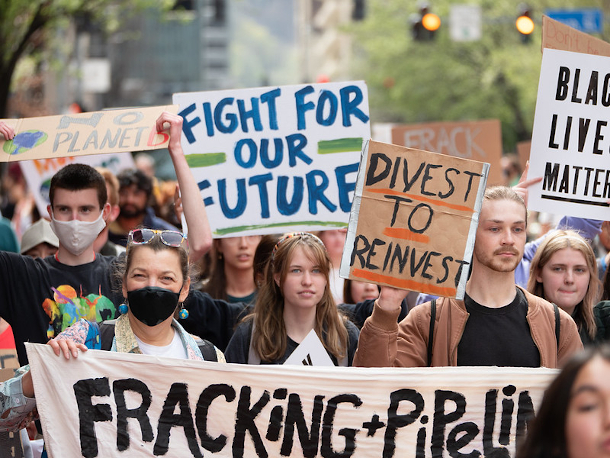
Environmental activists have fought for immediate climate action for years and some worry that the West Virginia v. EPA decision will set the administration back on its climate agenda. (Photo: Mark Dixon, Flickr, CC BY 2.0)
PARENTEAU: Right. This is a proposed rule from the SEC which has been attacked right out of the box by the Chamber of Commerce, by many of the same states attacking the Clean Power Plan that we've been talking about. And the financial risks of companies that are heavily reliant not only on producing fossil fuels like Exxon and BP and the other major oil companies, but all of the companies whose supply chains are heavily reliant on fossil fuel driven energy, are at financial risk. These assets that they're claiming are potentially worthless. There's this concept of stranded assets. All of the known reserves in the world of oil and gas can't possibly be burned without burning the planet, so to speak, without unleashing really catastrophic climate change. That's what all the scientists, climate scientists are saying, right? So the SEC is saying, this isn't just an environmental risk, it isn't just a public health and safety risk, or even a national security risk. It's a huge financial risk to investors, to banks, and so forth. And we know that the challenge to this SEC rule, once it's finalized, is going all the way to the Supreme Court, because it's a big rule with big implications. And we'll probably see a Supreme Court decision analyzing whether this new rule violates this new major question doctrine.
Today's #SCOTUS ruling on West Virginia vs EPA constitutes yet another blow as part of a coordinated attack on the health of Black, brown and low-income communities by the U.S. judicial branch, greedy corporations & billionaires, religious extremists, and white supremacists. pic.twitter.com/0UtuCSyjFT
— Green New Deal Network (@GND_Network) June 30, 2022
CURWOOD: Sounds like this Court thinks that Congress has to specify everything if something is going to change, and yet the Congress we have right now doesn't seem to be able to pass much in the way of actions.
PARENTEAU: That's right. The Court is oblivious to the reality of how difficult it is for Congress, first of all, to anticipate problems that arise in the future, and clearly articulate to the agencies what the scope of their authority is to deal with newly discovered threats. And it's also ignoring the fact that Congress created and authorized these expert agencies to exercise their judgment in the face of newly discovered threats and not have to return to Congress every time something like that arises. And so the Court is really re-fashioning the separation of powers. The Court itself, and Justice Kagan's dissent points this out, the Court is now deciding it will be the final arbiter of what Congress is both able to do in terms of delegating authority, and what agencies are able to do in interpreting the authority that Congress has given it when it's facing these new dangerous threats to public health and welfare.
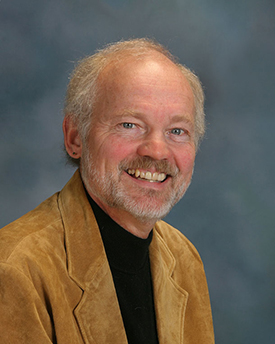
Former EPA Regional Counsel Pat Parenteau teaches environmental law at Vermont Law School (Photo: Courtesy of Vermont Law School)
CURWOOD: And Pat, looking at this case, how do you feel?
PARENTEAU: It's depressing, for someone who's been working in this field for 50 years, struggling to get laws passed, to get them implemented; what we're facing with this climate emergency is truly unlike anything we've ever faced. And the legacy that we are leaving for future generations is just scary to me. It's very disheartening. It's more than that -- it's terrifying, that somehow we can't get any of the branches of our government, the Congress, the courts, or the executive branch to come together and deal with the problem, with the solutions that are in plain sight. We have at our fingertips all of the technologies we need to make a huge difference in whether this planet is going to remain livable or not. And for someone like me, it's really a disheartening moment to see an opinion like this from our nation's highest court.
CURWOOD: Pat Parenteau is a Professor of Environmental Law at the Vermont Law School. Pat, thanks so much for taking the time with us today.
PARENTEAU: Thanks for having me, Steve.
Related links:
- Pat Parenteau’s article in The Conversation | The Supreme Court Curtails EPA’s Carbon Regulating Powers
- Axios | “Supreme Court Reins in Biden's Power on Climate Change”
- Politico | “Supreme Court Handcuffs Biden’s Climate Efforts”
- School of Policy and Government | “West Virginia v. EPA: The Supreme Court Weighs EPA’s Ability to Write Major Rules on Climate Change”
- Read the Opinion of the Court and Justice Kagan's dissent in West Virginia v. EPA
[MUSIC: Michael Hedges, “Two Days Old” on Live on the Double Planet, by Michael HedgesF, Windham Hill Records]
Beyond the Headlines

Researchers at Sichuan University have developed a fishbot that could help clean up microplastics in the ocean. (Photo: Naja Bertold Jensen on Unsplash)
CURWOOD: Well, it's that time in the broadcast when we turn to Peter Dykstra. For a look Beyond the Headlines, Peter is an editor with Environmental Health News. That's ehn.org and dailyclimate.org. He's on the line now from Atlanta, Georgia. Hey, Peter, it's been pretty hot here. What about down south with you?
DYKSTRA: Last week, we hit 100º a couple of times; this week, it's a little bit lower than that. But it's still summertime hot in Georgia.
CURWOOD: Ouch.
DYKSTRA: Well, Steve, let me tell you a couple of things that I found interesting this week. According to the World Food Program, most of the world's grain is not eaten by humans. We produce just under 3 billion metric tons of grain a year. And more than half of that goes to feed animals or is used as biofuels like ethanol.
CURWOOD: So even in this time of grain shortage, because we've got this war going on with Russia's invasion of Ukraine, and of course, the recurrent hunger problems, we're not eating half of what we produce, and it's going to animals?
DYKSTRA: Yeah, we're talking about all of the common staple grains: corn, wheat, millet, rye, oats. And the world is desperate to feed itself. Ukraine and Russia have more than complicated the situation. But all of that grain that goes to feed animals, in turn, those animals are used to feed us, which creates health problems, climate problems, and more.
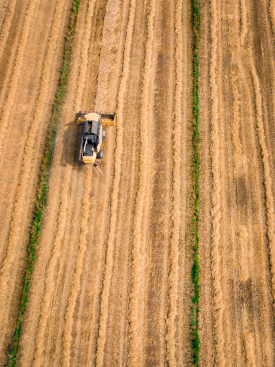
According to the World Food Program, humans eat less than 50% of the grain we produce. The majority of grain goes to animal feed and biofuel. (Photo: Kees Streefkerk on Unsplash)
CURWOOD: Peter, since most of the grain isn't eaten directly by humans, but goes to livestock, if we cut down on our eating of meat as a species, we will not only help the climate - because there's a lot of climate related gas emissions associated with all that meat - we also help lessen the shortage for other people on the planet who need to eat.
DYKSTRA: That's right. And if I can say this in the politest way possible, we could use a little bit less meat eating here, where of course other parts of the world don't get enough food and don't get enough nutrition.
CURWOOD: So, there's plenty of grain to go around for people to eat directly as long as we make the right choices. Heya, what else do you have for us today?
DYKSTRA: The word for today is: fishbots. There was a study published last week in the journal Nano Letters. Researchers in China at Sichuan University created a fishbot made out of composite material that can draw microplastics to itself as it swims. The Sichuan University team thinks that the new bot could be used to transport microplastics to another location where they can be collected and properly disposed of.
CURWOOD: Hey, Peter, just give me a little tech lesson. How exactly does this fish bot attract microplastics to it?
DYKSTRA: These fishbots react to a near-infrared light laser. Blinking the laser on and off causes the fishbot tail to flap back and forth acting like a fish. And as it moves along, plastic material sticks to the body of the fishbot.
CURWOOD: This would be an amazing solution to a huge problem. I mean, we're literally choking the oceans with microplastics. But it sounds like this isn't exactly an inexpensive device.
DYKSTRA: Not necessarily inexpensive, not necessarily efficient, and certainly not necessarily something that's going to rid the world of the microplastics problem. But it's an innovation. And if we have 1000 innovations, we might be able to put a dent in the huge problem of plastic pollution.
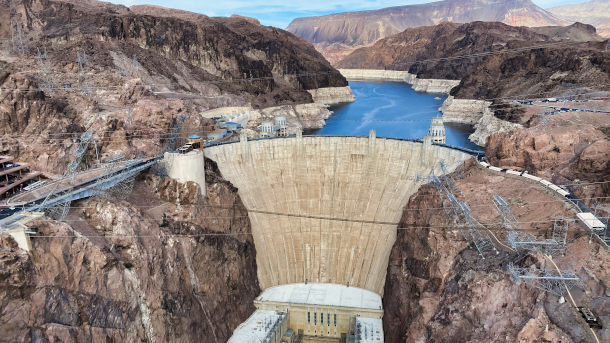
On June 25th, 1929, President Herbert Hoover authorized construction of the Hoover Dam (originally Boulder Dam). Today, overuse and drought threaten the American Southwest’s water supply. (Photo: Ryan Thorpe on Unsplash)
CURWOOD: Okay, well, I like that, a sign of hope to deal with the plastic problem. Hey, what do you have from the annals of history for us today?
DYKSTRA: On June 25th, 1929, President Herbert Hoover authorized the construction of a huge dam at the Boulder Canyon near the very small town of Las Vegas, Nevada. The Boulder Dam was eventually renamed the Hoover Dam, and it supplies water and electricity to farms and homes in Nevada, Southern California, and Arizona.
CURWOOD: There doesn't seem to be a whole lot of water in the Colorado River system now to keep operating the Hoover Dam the way it once operated.
DYKSTRA: The Colorado River and the Southwestern US is in crisis over water. LA, San Diego, Orange County, Las Vegas, Phoenix. And even before you get to watering the populations in the cities or providing hydropower for them, about 70% of what comes down to the Hoover Dam is used for agriculture. So, the Hoover Dam is going to have to work overtime. And they're going to have to find more new ways to conserve water and to find water to keep the American Southwest powered and watered.
CURWOOD: I think you're right, Peter. I mean, we're facing a real crunch there, thanks to the climate and thanks to the development that we've brought to the desert southwest. Thanks, Peter for all these stories. Peter is an editor with Environmental Health News, that's ehn.org and dailyclimate.org, we'll talk to you again real soon.
DYKSTRA: Okay Steve, thanks a lot, talk to you soon.
CURWOOD: And there's more on these stories on the Living on Earth webpage, that's loe.org.
Related links:
- The Economist | “Most of The World’s Grain Is Not Eaten by Humans”
- The Daily Beast | “Can a Future Fleet of Robotic Fish Clean Up the Ocean?”
- PBS | “Building the Hoover Dam”
[MUSIC: Clancy Eccles, “Don’t Brag, Don’t Boast” on Artist’s Choice-Bob Dylan, by Clancy Eccles, Sony/BMG]
BASCOMB: Coming up – how to stop a mega project that would disrupt a local ecosystem. Keep listening to Living on Earth.
ANNOUNCER: Support for Living on Earth comes from Sailors for the Sea and Oceana. Helping boaters race clean, sail green, and protect the seas they love. More information at sailorsforthesea.org. Support also comes from Friends of Smeagull the Seagull and Smeagull’s Guide to Wildlife. It’s all about the wildlife right next door to you! That’s Smeagull, S - M - E - A - G - U - L - L, SmeagullGuide.org.
[CUTAWAY MUSIC: MUSIC: The Crusaders, “So Far Away”, on Crusaders 1, The Verve Music Group]
Saving the Mekong River
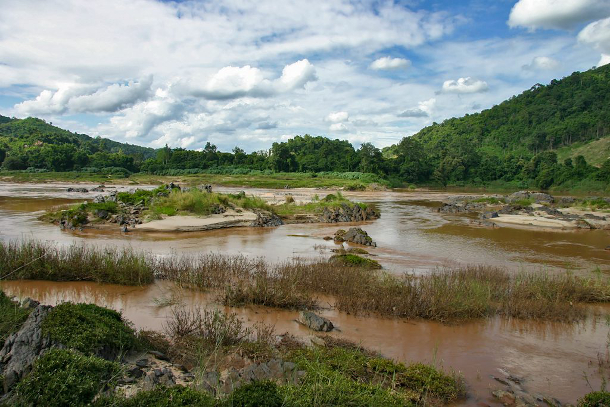
The Mekong River in Thailand (Photo: Goldman Environmental Prize)
CURWOOD: It’s Living on Earth, I’m Steve Curwood.
BASCOMB: And I’m Bobby Bascomb.
The Mekong River flows some 2,700 miles from the mountains of Tibet before draining into the South China Sea. Along the way, its fisheries, tributaries, wetlands, and floodplains are vital to the livelihoods of more than 65 million people. In fact, the Mekong is considered the world’s largest inland fishery, yielding up to 25% of the global freshwater catch. But in the year 2000, China, Myanmar, Laos, and Thailand jointly signed the Agreement on Commercial Navigation, a project to dredge and blast sections of the river to allow navigation for 500-ton freighter ships, raising concerns for local fishers and farmers. The project has been implemented on parts of the Mekong in China, Myanmar, and Laos but Niwat Roykaew was determined to stop it on his section of the Mekong in Thailand. A lifelong teacher in local schools, Niwat is also founder of the Chiang Kong Conservation group and he set about organizing his community to mobilize against developing the river. It took nearly a decade, but eventually their activism bore fruit and the Thai government announced an end to blasting on the Upper Mekong River. It’s likely the first time the Thai government cited environmental concerns for cancelling a transboundary project. Niwat Roykaew joins me now for more, starting with why he was moved to act.
ROYKAEW: When we heard about this project we were very concerned about impacts it would have on ecosystem services the river provides, including aquatic life. The fishing folk here depend on a healthy river. Our income and livelihoods are attached to the health of the Mekong river. So we were concerned that our way of life would change.
BASCOMB: Well, tell us a bit please about the life on the Mekong River, both for wildlife you know, maybe some of the unique biodiversity that’s there, and how local people use the river, why is it important for them?
ROYKAEW: For us living in the area, the Mekong River basin provides us with food and is essential to the local economy. 25 years ago, fish and river resources were abundant. We used to walk to the Mekong river with nets and easily catch food. But when several development projects were imposed, like hydropower dams and rapid blasting for large-scale navigation, the population of fish dropped dramatically and changed our lives. We understood then that the Mekong river is a life support for us.
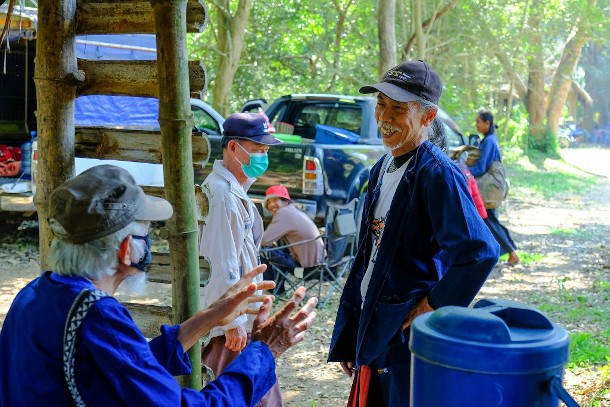
Niwat Roykaew with community members (Photo: Goldman Environmental Prize)
BASCOMB: So you were concerned, then, that if this project went through that it would be even harder for people to make a living, to fish and to use the river as they always had. Is that right?
ROYKAEW: Yes, when we heard that the Mekong River would be blasted for rapid navigation, our primary concern was the effect it would have on the river’s health. It was not just me that was concerned. Many children of the Mekong river, including fishermen and farmers, also believed it would be devastating. Their lives depend on the river’s health and its role as both habitat and breeding ground for many species of fish. The elders who were born here on the bank of the Mekong were concerned about rapid blasting taking place in the river’s rocks and sand dunes because they act as natural dams and their destruction could have an effect on the river’s water level.
BASCOMB: So, you became determined to stop this project, and from what I understand, you were already running an NGO, the Chiang Kong Conservation Group which you started back in the 90s. Tell us please about what prompted you to start that NGO, and how you used it to mobilize against the Mekong River project more recently.
ROYKAEW: In our community, we view the Mekong river as our mother, our provider. It's a source of inspiration for our grassroots organization. Our mission is to protect and conserve it. We believe in local knowledge so we spent a lot of energy researching the best ways to empower small-scale fishermen and farmers so they can speak out to decision makers and rapid blasting engineers about the impact this project would have on the river and their lives.
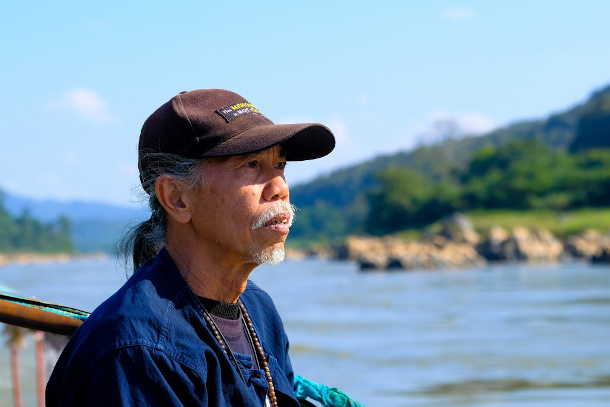
Niwat Roykaew on the Mekong River (Photo: Goldman Environmental Prize)
BASCOMB: Now, I understand that the road was bumpy, but ultimately you and your organization were able to pressure the Thai government into canceling the project. Can you tell us about that, please? How were you able to convince them; what ultimately won the day for you?
ROYKAEW: The main factor that contributed to our success was the drive from the local community. We told them that even though they are ordinary people, as citizens they have the right to stand up and participate. If our villagers didn’t start to fight for their rights 20 or so years ago when the project was proposed, the rapid blasting would’ve already happened and we wouldn’t have the natural habitat that we do today.
BASCOMB: Being an environmental advocate can be extremely dangerous in some parts of the world, even deadly, honestly. And I would think that there was probably a lot of money at stake here with this project. To what degree did you ever feel unsafe or threatened doing this type of work?
ROYKAEW: There were definitely times I felt unsafe. There were, of course, investigations. But once, I was invited by province officials to discuss why I was opposing a government project. So, I sat down with them to explain how this project would be devastating for the people of the Mekong river, and 30 minutes into the conversation they agreed with me and we created a mutual understanding.
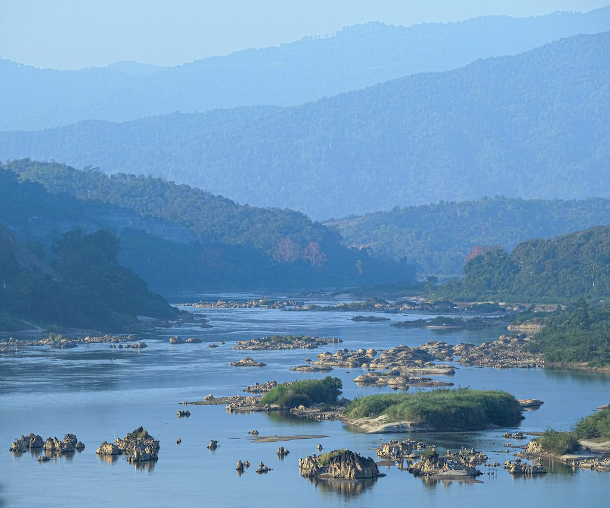
The Mekong River in Thailand (Photo: Goldman Environmental Prize)
BASCOMB: Well, what’s next for you, Sir, now that this project has been canceled and you’ve won the Goldman prize? What’s your next endeavor?
ROYKAEW: As children of the Mekong River, we see that our mother is still unwell. We have to keep working to protect her. Even though the rapid blasting project was terminated, threats to the Mekong river still remain. So now, we’re focusing on building the next generation of this movement, raising the grandchildren of the Mekong, so that we can keep supporting the river.
BASCOMB: Niwat Roykaew is head of the Chiang Khong Conservation Group and this year’s Goldman Prize winner from Asia.
Related links:
- Learn more about Niwat Roykaew
- International Rivers “Mekong environmental leader Niwat Roykaew wins prestigious Goldman Environmental Prize”
[MUSIC: Li Giao Duyen, “Kim Sinh” on The Rough Guide to the Music of Vietnam, by Li Giao Duyen, King Record Company]
Saltier Soils in a Warming World

A white, barren patch of agricultural land is visible where salt has become concentrated in a field. (Photo: USDA NRCS South Dakota, Flickr, CC BY-SA 2.0)
BASCOMB: As we’ve been discussing, the Mekong River is vulnerable to damage from development and large-scale infrastructure projects. It’s also in the crosshairs of one of the dangers from the climate crisis. Parts of the river are becoming saltier because of saltwater intrusion from rising seas. The Mekong River Delta in southern Vietnam is a fertile rice-producing region and home to more than 20 million people, but salty ocean water is pushing into the delta and threatening livelihoods. Just this spring, during the dry season, the salinity boundary reached 40 miles upstream, more than 10 miles farther than it has historically. Freelance journalist Fred Pearce wrote about rising salinity in the Mekong Delta and around the world for Yale Environment 360 and joins me now from London. Welcome back to Living on Earth, Fred!
PEARCE: Thank you.
BASCOMB: So what's happening in the Mekong Delta? Why is there rising salinity there?
PEARCE: There are two reasons. Mekong has got the worst of both worlds. It's got big dams being built upstream, particularly in China, and they're stopping the flood flows of fresh water coming down the river. So fresh water is not getting into the river delta. Added to that, it's got sea level rise coming in from the ocean. So the power of the sea to invade the river delta is increasing. So, with less freshwater coming down and more saltwater coming in, the delta region is getting more salty; there's a kind of barrier of salt which is pushing in. And that's having a really damaging effect on farmers, for people trying to drink the water as well, but principally for farmers and rice farmers. This is one of the world's great areas for rice growing, and it is under threat. We often think about sea level rise and sea invasions as being about water inundating areas, flooding the coastal regions. But in fact, in many regions, much before that happens, the saltwater gets in there, the salt invasion is poisoning crops, poisoning water supplies, and in many cases, people are already having to leave these regions. They may be not flooded, but they're unlivable.
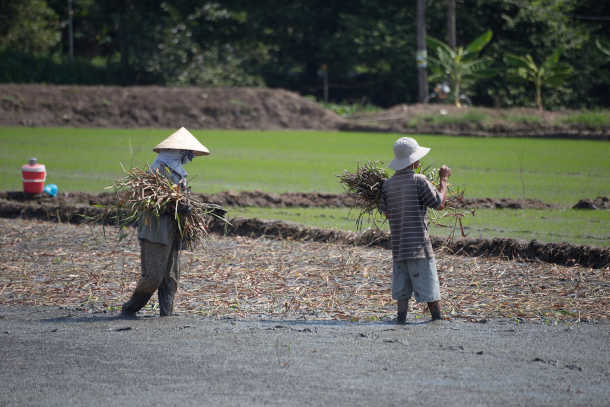
Rice farmers in Vietnam’s Mekong River Delta, which is becoming saltier and less fertile as sea levels rise and upstream dams block freshwater flows (Photo: Alex Berger, Flickr, CC BY-NC 2.0)
BASCOMB: And I would imagine that the Mekong River Delta is not the only delta in the world where this is a problem.
PEARCE: Absolutely not. It's a universal feature. Most of our world's rivers now have dams on them and that means that flows down them are reduced, particularly the flood flows that are most important for keeping their delta regions fresh rather than salty. And of course, sea level is rising. So we can see, for instance, in Bangladesh in the river Ganges and Brahmaputra Delta, a huge delta region there: salt is forcing farmers out even before the rising tide. The same on the Indus River Delta region in Pakistan. And these are the ones that we talk about most, because they're the most densely populated river deltas, but it's a global phenomenon. It's happening everywhere.
BASCOMB: And from what I understand, it's not just happening along the coasts, we're also looking at inland soils that are becoming saltier. Can you explain that for us, please?
PEARCE: That's right. Really, the whole world is becoming saltier. There's a kind of salt invasion going on globally. And it's not all to do with climate change. So for instance, in North America and in Europe, we put a lot of salt onto our roads in the winter in order to stop them freezing over, and a lot of that salt gets into rivers. So we find that river ecosystems, freshwater ecosystems far from the ocean are turning more saline after that happens. We see mining often pumps salty water from underground and pours it in eventually into rivers, so we're seeing salinization as a result of that. And also irrigation projects for farming are a major cause of salination. In an irrigation system, where a large amount of water is put on to the land to be taken up by the crops, the salt gets left behind in the soils. And we see in many parts of the world a buildup of salt. So we're seeing all these effects, and climate change is going to make them worse. We've talked about the saline intrusion as people talk about it, the salt coming in from the oceans as sea level rise. But if you think about how climate change affects inland regions, especially dry regions, as it gets warmer, evaporation rates go up really quite staggeringly fast. So the water is evaporating, again, leaving behind salt in the land. So many parts, arid parts, of the world are suffering already from this. And as temperatures rise and evaporation rates rise, more and more salt is going to accumulate in fields, but also in underground water reserves. It’s a kind of hidden crisis. I don't think we've really got to grips with it yet.
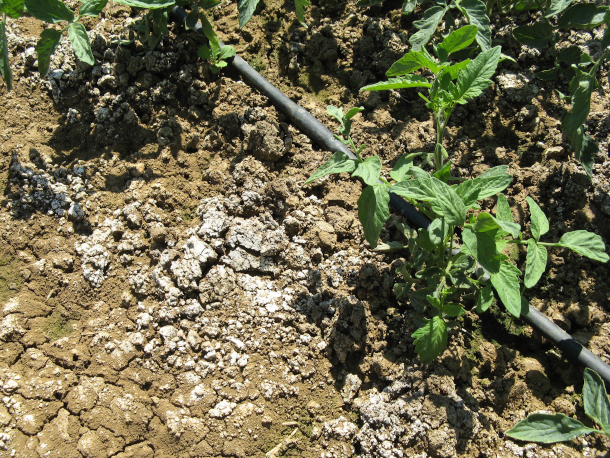
White salt deposits on the surface of the soil in a field where tomatoes are grown in Tunisia. (Photo: Jean-Yves Jamin, Water Alternatives Photos, Flickr, CC BY-NC 2.0)
BASCOMB: You know, I think this notion that irrigation can contribute to salt on the land seems, you know, kind of counterintuitive to a lot of people. Can you talk a little bit more about that? Why would watering crops with freshwater add salt to the soils?
PEARCE: Well, because no water is entirely fresh; all water flowing over the land, eroding the mountainsides as it goes, coming out of whether it's the Andes or the Himalayas or wherever the rivers rise, it will erode and capture a certain amount of salt. And it brings that downstream, and it brings it into irrigation systems, in through the irrigation canals until the water is poured onto the soil so that crops like cotton or corn can grow. Now the crops are damaged by salt, and they pick up some salt but they leave most of the salt behind in the soils. They want the water, not the salt. So the water is coming off the land, but the salt is being left behind. So what started as a very small and perfectly reasonable amount of salt gradually builds up. And there are irrigation projects around the world, which are now pretty much unusable because salt builds up to the extent that they look white, I mean, they almost look like snow because there's an accumulation of salt crystals on the surface of the soil. And at that point, the soil becomes infertile and the crops can't grow. In the parts of Central Asia, we know about the Aral Sea that's been drying up, the Aral Sea was once one of the world's biggest inland seas, has dried up because most of the water has been taken out of the rivers that feed it to irrigate crops, especially cotton. But we're now finding that those cotton fields are accumulating so much salt, and it just stays there. And the only way of getting rid of it is to push more water, flush more water through the soils, and try and sort of gather up the salt and take it out. But with water in short supply, that is an increasingly difficult thing to do.
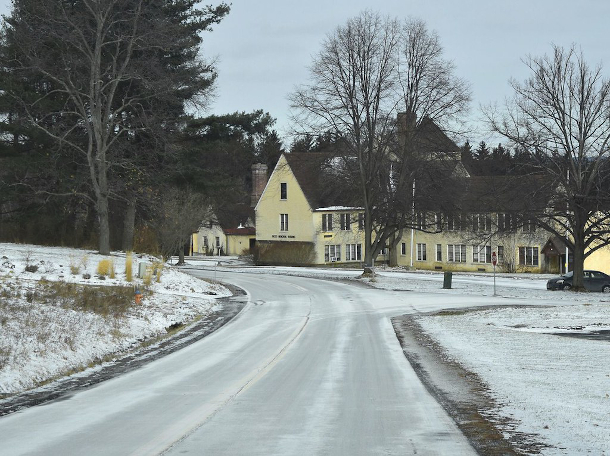
In winter, road salt helps keep ice at bay but it also washes out into the surrounding soils, streams and rivers, creating ecological and agricultural havoc. (Photo: Jo Zimny, Flickr, CC BY-NC-ND 2.0)
BASCOMB: Fred, what about the role of fertilizer? I believe a lot of fertilizers tend to have salt in them as well.
PEARCE: Yes, salt is an ingredient in fertilizer and the more fertilizer we put on the land, the more salt we put on the land. A bit like putting more water on the land, we get more salt on the land. That has a long-term devastating consequence on the quality of the soils and their ability to grow crops.
BASCOMB: You write in your article that salts intrusion in Bangladesh has already reduced rice production by about 30% in the last 15 years or so. I mean, that's really significant.
PEARCE: Exactly right. At that point, farmers start thinking, Well, can we carry on? Or do we have to move? Now in Bangladesh, they've been quite creative, really. In many regions, they've stopped growing rice in their paddy fields and they're converting their paddy fields to raising prawns. So they're doing aquaculture in what used to be agricultural land. Well, that's one way forward. Aquaculture, if you're bringing more salty water onto the land, your neighbors won't like it, because you're adding to the salt on the environment and all the other rice farmers have to give it up as well. But that's one response. And it happens in the Mekong, and in Bangladesh, we see that. But beyond a certain point, farmers simply give up. So we're seeing salt as a cause of environmental refugees and environmental migration.

Women farmers in Bangladesh, where sea level rise is pushing farmers out. (Photo: WorldFish, Flickr, CC BY-NC-ND 2.0)
BASCOMB: So you have the present threat of food insecurity in a lot of the world. But what about the local area itself and rising salinity? How does that affect the health of the people that are living in the area?
PEARCE: We're beginning to see health effects from the buildup of salt in the water that people drink. So if you're drinking large amounts of salt from the water, I mean beyond a certain point, it's salty, it'd be impossible to drink, but a lot of water is just kind of borderline salty. And people are accumulating sodium and other ions that are in the salt. And these have an effect on hypertension, they can raise your blood pressure levels. There's been some studies in Bangladesh suggesting that maybe 10,000 people a year are dying of these effects directly, from having to drink salty water. Salt can sometimes make water more liable, as it runs through the pipes towards our homes, to dissolve lead from lead piping. In parts of the world where there's lead piping, that's a considerable threat. We had the crisis in Flint in Michigan a few years ago because they started taking water from a river source and putting it through lead pipes without realizing that the water would pick up the lead and deliver it to the citizens, and lead is a nasty poison. But one of the reasons, the chemical reasons, why the river water was accumulating, it was picking up that lead, was because it was quite salty water. So it wasn't the only reason why there was a problem there. But it was a contributory factor.
BASCOMB: Well, this is a multi-pronged issue here, you know, we're looking at health problems, mass migration, collapse of ecosystems, potentially; what can be done about this problem of rising salinity in the soils now that we know so much about it?
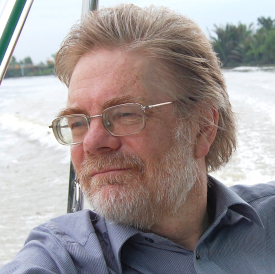
Journalist Fred Pearce on the Mekong Delta (Photo: Courtesy of Fred Pearce)
PEARCE: The big thing we have to do, as with many of these things is to stop climate change, because climate change has become the long-term driver of this. And unless we can stop that, things will probably in most places carry on getting worse. But there are many things that we can start to do to reduce the other causes of salination. So we need to think very carefully about how we run our irrigation systems, to make them more efficient so less water has to go on to the fields. And that means less salt is brought onto the fields. And we have to think about drainage systems in irrigation networks so that the salt can be drawn out again. Now it will go into rivers, and it'll have ecological consequences. But if we want to preserve the food supplies, we need to do that. We need to think about how we operate our dams. So we need to think about operating dams so that they provide enough water downstream at the right times of year to allow what is often the sort of flood pulse of during the wet season. So that if there's salt buildup in the delta, it can flush that out. We need to think, in North America and Europe and other places where this happens, we need to think about pouring salt in the way that we now do in a rather reckless manner onto our roads and not really caring that much of it drains away into rivers. We're going to have to think about putting less salt on, perhaps using alternatives to salt. And if we do put salt on, we're going to have to think about capturing that in drains, so that it doesn't go back into the rivers. I think once we start thinking about salt as an issue, we will find solutions. And they're not just about climate change, but if you like, climate change is the one which is going to affect most people over the long term. So we have to fix that. But I think we can do a lot of other things first.
BASCOMB: Fred Pearce is a freelance author and journalist based in the UK. Fred, thank you so much for your time today.
PEARCE: Thank you.
Related link:
Fred Pearce for Yale e360 | “Salt Scourge: The Dual Threat of Warming and Rising Salinity”
[MUSIC: Andres Salguero and Christina Sanabria, “El caballito azul” on La Luna, by Andres Salguero, Salsana Records]
CURWOOD: Coming up: prisoners at risk from heat waves and wildfires related to climate change. That’s just ahead on Living on Earth.
ANNOUNCER: Funding for Living on Earth comes from you, our listeners, and United Technologies, combining a passion for science with engineering to create solutions designed for sustainability in aerospace, building industries, and food refrigeration.
[CUTAWAY MUSIC: Tom Teasley, “Nights Over Baghdad” on All the World’s a Stage, by Tom Teasley, Tom Teasley Music]
Climate and Punishment
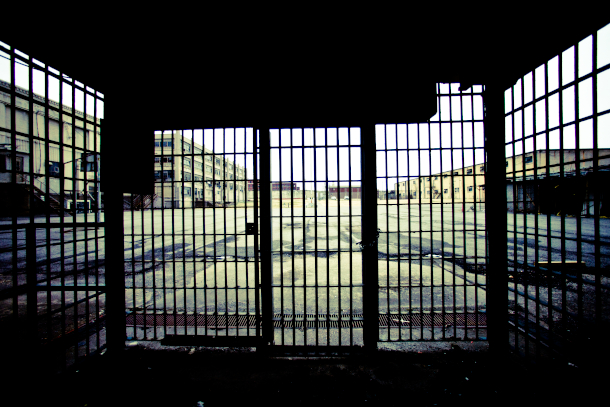
In extreme heat, prisoners’ health can decline, especially for those with pre-existing conditions. In a month-long heat wave in Texas in 2011, 10 incarcerated people died from heat-related illnesses. (Photo: Thomas Hawk, Flickr, CC BY 2.0)
BASCOMB: It’s Living on Earth, I’m Bobby Bascomb.
CURWOOD: And I’m Steve Curwood.
Prisons are not expected to be pleasant, but with the growing risks of extreme heat waves and wildfires, some are ill-prepared to keep jail terms from becoming death sentences. Some inmates have pre-existing health conditions that are exacerbated by heat and wildfire smoke, and some take mental health medications that can also make people more susceptible to heat. Reporters for the Intercept have found that more than a third of the 6500 or so jails and prisons in the US are in places where 50 days a year on average the heat index is 90 degrees or more. The climate hazards for prisoners come from a pervasive lack of air-conditioning, faulty infrastructure, and vague evacuation plans. Reporter Alleen Brown, worked on this investigation for the Intercept and joins us now. Alleen Brown, welcome to Living on Earth!
BROWN: Thank you so much for having me.
CURWOOD: So, tell me a story of a prisoner or prisoners who have been mistreated because of situations related to climate disruption. I know you have many, but maybe you can tell me one?
BROWN: Yeah, absolutely. I think the most striking story that I've heard is that of Angel Argueta Anariba. So, Angel grew up in a family that lived off of farming in Honduras. So in 1998, Hurricane Mitch hit Honduras, and his family lost everything, you know, property, land, jobs, crops, and he had two little kids. So, he traveled to the U.S. to try to support his family.
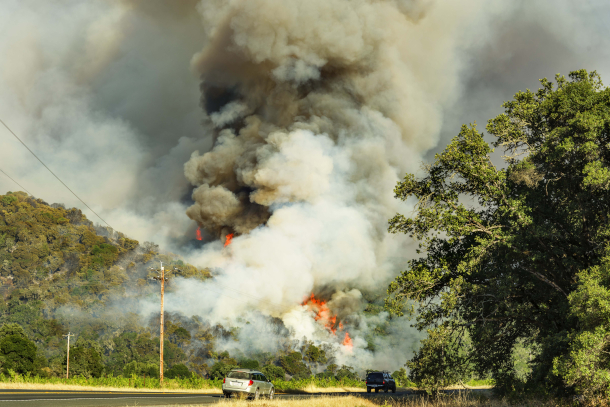
Prisons in California often have minimal evacuation plans for wildfires like this one in Mendocino County in 2018. One in five California correctional facilities are in the 95th percentile for wildfire risk in the U.S. (Photo: Bob Dass, Flickr, CC BY 2.0)
CURWOOD: That's right. I believe that something like 20% of the housing stock in Honduras was destroyed in that storm.
BROWN: Yeah, I mean, the country was hit really hard, and the government just did not have the capacity to respond effectively. So Angel came to the U.S. and he lived here for about a decade before he was arrested for an incident that he attributes to self-defense. He served out a seven-year sentence that the court deemed to be appropriate. But then like many immigrants, he was delivered directly to ICE detention because he was undocumented. So the worst was in 2020, at the Catahoula Correctional Center, when Hurricane Laura hit, the lights and water went out at the facility for four to five days.
CURWOOD: Now, where is this? What state?
BROWN: Sure, this is in Louisiana. So you know, a state that is notorious for its climate vulnerability, and a state where there's actually a lot of ICE detention facilities. So with the electricity out, there was no air conditioning and according to Angel, the space felt like it was about 100 degrees. A couple of inches of water pooled on the ground and maybe one of the worst parts was that the toilets weren't working, so they overfilled. Some people were forced to defecate on disposable trays that meals had been served on. And with workers avoiding entering the dorms, the garbage piled up. Angel said the smell was just excruciating. And you know, for Angel who has asthma, the heat and the smell really exacerbated that health condition.

Prisoners during recreational time at the Orleans Parish Prison. During Hurricane Katrina in 2005, prisoners were left locked in their cells as facilities flooded. (Photo: Bart Everson, Flickr, CC BY 2.0)
CURWOOD: So now, what's been the response of the legal system? I mean, there's what, was it the Eighth Amendment of the U.S. Constitution against cruel and unusual punishment, that sort of thing?
BROWN: So, especially in Texas attorneys have argued Eighth Amendment violations due to conditions related to heat. You know, in Texas, less than a third of state prisons have full air conditioning, or that was the case as of 2020. 21 facilities at that point had no air conditioning at all. And so, around 2010-2011, a number of people died due to heat related conditions and family members sued. So, because of those lawsuits, Texas had to start taking some measures to protect the health of the most vulnerable people within that system. But you know, family members of incarcerated people and people who are incarcerated themselves say that those measures have not been sufficient to protect them.
CURWOOD: Now, what kinds of government actions are we seeing to deal with this? I mean, of course, the South has long had the reputation of being rough on prisoners. What about more progressive states like California?
BROWN: Sure. So, I would say California has also been really slow to address these issues. You know, in California, one of the climate issues that people who are incarcerated have really called out again is the issue of wildfires. About a fifth of the facilities in the state we found are in the 95th percentile for wildfire risk in the nation. So, there, a lot of the, the community members organizing around this issue have focused more on getting facilities shut down and getting people released than they have on necessarily infrastructure adjustments. And the governor of California has committed to shut down a handful of facilities in the next few years. But organizers are saying that they want 10 facilities shut down and 50,000 people released in the next five years. And they don't want a bunch of money invested into new infrastructure.
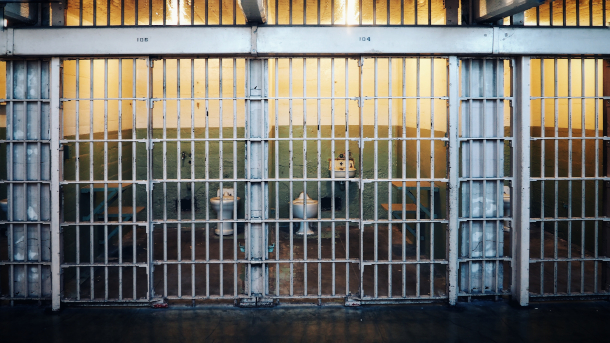
When power outages occur in prisons, waste systems can fail. Conditions can quickly become unsanitary and hazardous. (Photo: Umanoide on Unsplash)
CURWOOD: Briefly, what's their argument? Why do these people need to come out of jail?
BROWN: So I mean, the argument of a lot of researchers, in addition to organizers, is essentially that this system of mass incarceration is at a crossroads where, with the climate crisis deepening, government officials can either invest a whole lot of money in new infrastructure or they can start to think about new ways of accountability. So, a lot of people are arguing that there's no infrastructure investment that will be sufficient to address this problem. And the only real climate adaptation strategy for prisons is to shut them down. A lot of people also argue that these facilities and the system of mass incarceration doesn't actually do what it's supposed to do. You know, these facilities don't rehabilitate people or keep communities safe. Like climate change, prisons make vulnerable communities more vulnerable. I think for a lot of people organizing around abolition, climate is just another reason to think of new accountability strategies.
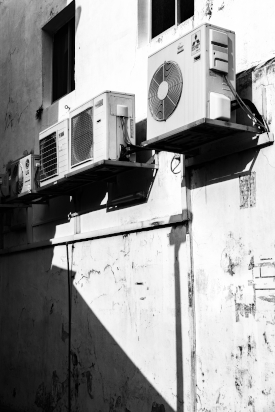
Air conditioning is widely regarded as an essential utility in the American South and West. At least 14 of the hottest states do not have universal air conditioning in their correctional facilities. (Photo: Gervyn Louis on Unsplash)
CURWOOD: So, sometimes to fight the wildfires prisoners are used in places like California, but to what extent are prisoners at risk from the smoke and even the flames of wildfires in California.
BROWN: So, one example was the California Correctional Center in Susanville, California. So, as people were told to prepare to evacuate in the community itself, people inside one of the units at the California Correctional Center had been without power for about a month, because the wildfires had taken down power lines in the hills nearby. Most of the facility was on generator power, but this unit had an emergency generator that failed. So, they'd been sitting basically in the dark with little to distract themselves, you know, more restrictive detention, they couldn't kind of have their time in communal areas because of the power outage. And all this time, the anxiety was just building around the wildfires that were approaching. At times the ventilation would go out, and it was quite smoky. One person that I spoke to said that, in his dorm, there were padlocks actually put on individual cells because the locking system was typically electronic. And when he asked a guard what would happen if the fires came too close, he basically told him that “you guys are staying here.” Whether or not that's true, it's very scary for someone who's stuck in a facility as fires are coming closer. And as I tried to find out exactly what kinds of plans California has in place where it comes to evacuations and wildfires, I really got minimal transparency. Basically, California says that, of course, they have emergency plans, evacuation plans, but they cannot share any details because it's a security risk. For families that have had loved ones living through the COVID pandemic while incarcerated, that kind of vague reassurance is just not enough.
The U.S. has the highest incarceration rate in the world. Prisoners are some of the most vulnerable to the climate crisis given that they’re at the mercy of a prison system plagued with problems.
— The Intercept (@theintercept) February 12, 2022
Climate and Punishment: https://t.co/pyDC8aF0xU pic.twitter.com/j60KEnNVeS
CURWOOD: So, in your view, how does the climate crisis and its disproportionate impact on people incarcerated, how does that correlate with systemic racism?
BROWN: Yeah, I mean, so we know that people of color, Black people and Indigenous people in particular, are disproportionately incarcerated. And so when these climate impacts are hitting the system of mass incarceration, it's disproportionately hitting again, especially Black and Indigenous people, but people of color more broadly. And where it comes to ICE detention, Latinx people disproportionately. So, it's absolutely an environmental justice issue.
CURWOOD: So, the Biden administration has announced its intent to prioritize environmental justice. So, what are we seeing from the Biden administration to address this disproportionate impact of the climate crisis on incarcerated people?
BROWN: So, I think the main thing we're seeing from President Biden is calls for more studying. So, via a pair of executive orders, Joe Biden is asking federal agencies to come up with climate adaptation plans. Something similar is happening with the Department of Homeland Security, which includes ICE. Their report describes how the climate crisis likely will increase migration across the U.S. Mexico border, and their facilities will be overwhelmed. And DHS has suggested that they may fortify the U.S. Mexico border. You know, we do see some movement by federal legislators to start to protect these facilities. For two years running, Senator Tammy Duckworth has introduced a bill that would require the Bureau of Prisons to submit annual damage reports describing how federal prisons and people inside did during major disasters that year. It would also encourage corrections officials to consider home confinement or early release to manage disasters in carceral facilities.
CURWOOD: I take it that legislation hasn't passed, though.
BROWN: No, that legislation has not passed. And that's, I think, something that we've seen across the U.S. You know, in Texas, organizers have really focused on trying to advance legislation to install air conditioning in state facilities and without leadership from Governor Greg Abbott, that legislation has failed repeatedly.
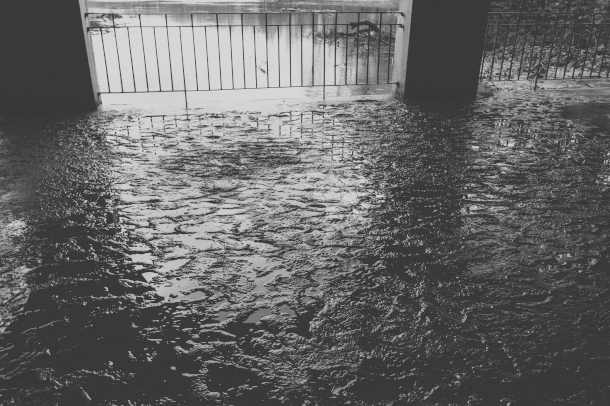
Prisons are often unequipped to deal with severe weather events. At the Catahoula Correctional Center in 2020, Hurricane Laura caused the lights and water to go out for four to five days. (Photo: RubyT, Flickr, CC BY 2.0)
CURWOOD: Talk to me about the human cost to families as well as those people incarcerated when these issues are being consistently ignored. Sounds like the Biden administration is studying, making promises, sounds like in California, again, there's studies and making promises, but I haven't heard you say that, really, a lot of action is being taken.
BROWN: So, one of the families that I spoke to was Casey and Justin Phillips in Texas. Justin Phillips was incarcerated at the Coffield Unit, which is a state prison that lacked air conditioning. And he has a rare kidney condition that's quite severe. So, kidney conditions can be particularly exacerbated by extreme heat, and that was the case for Justin. So, during the year that Justin Phillips was incarcerated without air conditioning, he said that his health really deteriorated. In addition to not being able to take his medications all the time, because he said that he was not always escorted by guards to do so, he also was unable to routinely take his blood pressure medication. That's because the medication made him more sensitive to the heat. So, Justin's wife, Casey basically fought for him day in and day out. She was calling the prison and trying to get him transferred. She was pushing for them to give him the care that he needed. And ultimately, he was transferred into an airconditioned unit. By then, his kidney function was much worse. So, throughout that fight, Casey began to realize the scale of the problem. And she started an organization called Texas Prison Air Conditioning Advocates. Alongside other family members of incarcerated people and formerly incarcerated people, she began to push the state legislature for action. Now, that organization is called Texas Prison Community Advocates, and they're continuing that fight. But Casey ultimately had to step down because she needed to care for her own health and the health of her family members. Justin has since been released, and now he's on dialysis daily, and his prognosis for the next five years is not great.

Alleen Brown is a New York-based reporter focused on environmental justice issues. Her work has been published by The Intercept, The Nation, In These Times, YES! Magazine, and various Twin Cities publications. (Photo: Courtesy of Alleen Brown)
CURWOOD: Alleen, to what extent is this problem related to the attitude of some people that well, prisoners are supposed to be punished and we shouldn't coddle them?
BROWN: Yeah, I mean, I think that's something that's often raised when the question of installing air conditioning comes up. You know, that they did something wrong and that this is the consequence. But for one thing, I think a lot of reporting and investigations over in recent years have showed that our system of mass incarceration is not perfect, and a lot of people who are innocent end up in these facilities. I think that I would also again point back to the Eighth Amendment that bars cruel and unusual punishment. Some judges have affirmed that some of these extreme heat conditions do qualify as cruel and unusual punishment. And if we're looking at a climate that is going to get dramatically hotter, then that legal argument will only become stronger. You know, another statistic that came out of our reporting that was really striking to me is that today, no carceral institution is located in a county with more than 50 days a year at 105 degrees. By 2100, almost 700 facilities will be in counties that see that level of heat, mostly in Texas, Florida, and Louisiana. I think we can all agree that 50 days a year at 105 degrees is quite severe.
CURWOOD: Alleen Brown has covered the intersection between the climate crisis and mass incarceration for publications including The Intercept. Thanks so much for taking the time with us today.
BROWN: Thank you so much for having me.
Related links:
- The Intercept | “Climate and Punishment”
- The Intercept | “Video: Politicians Ignore Vulnerable Prisoners as Climate Change Worsens”
- The Intercept | “Migrants Fleeing Hurricanes and Drought Face New Climate Disasters in ICE Detention - Alleen Brown”
[MUSIC: Eddie Cotton, “Here I Come”, on Here I Come, DeChamp Records]
CURWOOD: Living on Earth is produced by the World Media Foundation. Our crew includes Naomi Arenberg, Paloma Beltran, Chloe Chen, Iris Chen, Josh Croom, Jenni Doering, Delaney Dryfoos, Mark Kausch, Mark Seth Lender, Don Lyman, Louis Mallison, Aynsley O’Neill, Sophia Pandelidis, Jake Rego, Hannah Richter, and Jolanda Omari.
BASCOMB: Tom Tiger engineered our show. Special thanks for translation help to Non Charoenwattananon and Pianporn Deetes. Alison Lirish Dean composed our themes. You can hear us anytime at loe.org, Apple Podcasts, and Google Podcasts, and like us, please, on our Facebook page: Living on Earth. We tweet from @livingonearth. And find us on Instagram at livingonearthradio. I’m Bobby Bascomb.
CURWOOD: And I’m Steve Curwood. Thanks for listening!
ANNOUNCER: Funding for Living on Earth comes from you, our listeners, and from the University of Massachusetts, Boston, in association with its School for the Environment, developing the next generation of environmental leaders. And from the Grantham Foundation for the protection of the environment, supporting strategic communications and collaboration in solving the world’s most pressing environmental problems.
ANNOUNCER 2: PRX.
Living on Earth wants to hear from you!
Living on Earth
62 Calef Highway, Suite 212
Lee, NH 03861
Telephone: 617-287-4121
E-mail: comments@loe.org
Newsletter [Click here]
Donate to Living on Earth!
Living on Earth is an independent media program and relies entirely on contributions from listeners and institutions supporting public service. Please donate now to preserve an independent environmental voice.
NewsletterLiving on Earth offers a weekly delivery of the show's rundown to your mailbox. Sign up for our newsletter today!
 Sailors For The Sea: Be the change you want to sea.
Sailors For The Sea: Be the change you want to sea.
 The Grantham Foundation for the Protection of the Environment: Committed to protecting and improving the health of the global environment.
The Grantham Foundation for the Protection of the Environment: Committed to protecting and improving the health of the global environment.
 Contribute to Living on Earth and receive, as our gift to you, an archival print of one of Mark Seth Lender's extraordinary wildlife photographs. Follow the link to see Mark's current collection of photographs.
Contribute to Living on Earth and receive, as our gift to you, an archival print of one of Mark Seth Lender's extraordinary wildlife photographs. Follow the link to see Mark's current collection of photographs.
 Buy a signed copy of Mark Seth Lender's book Smeagull the Seagull & support Living on Earth
Buy a signed copy of Mark Seth Lender's book Smeagull the Seagull & support Living on Earth

